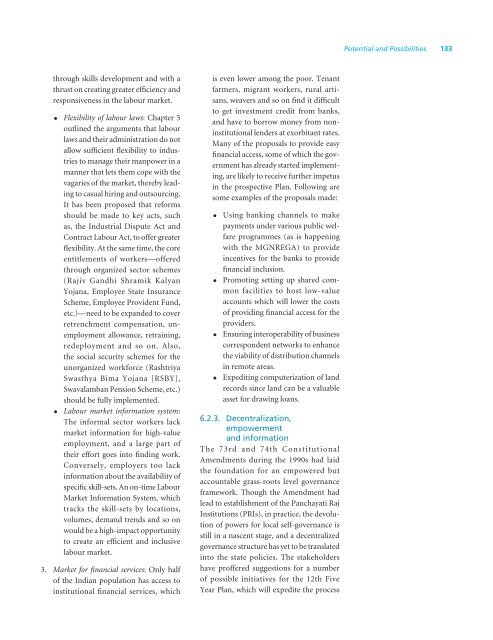SOIL Report 2011 - ACCESS Development Services
SOIL Report 2011 - ACCESS Development Services
SOIL Report 2011 - ACCESS Development Services
- No tags were found...
Create successful ePaper yourself
Turn your PDF publications into a flip-book with our unique Google optimized e-Paper software.
Potential and Possibilities 133through skills development and with athrust on creating greater efficiency andresponsiveness in the labour market.• Flexibility of labour laws: Chapter 5outlined the arguments that labourlaws and their administration do notallow sufficient flexibility to industriesto manage their manpower in amanner that lets them cope with thevagaries of the market, thereby leadingto casual hiring and outsourcing.It has been proposed that reformsshould be made to key acts, suchas, the Industrial Dispute Act andContract Labour Act, to offer greaterflexibility. At the same time, the coreentitlements of workers—offeredthrough organized sector schemes(Rajiv Gandhi Shramik KalyanYojana, Employee State InsuranceScheme, Employee Provident Fund,etc.)—need to be expanded to coverretrenchment compensation, unemploymentallowance, retraining,redeployment and so on. Also,the social security schemes for theunorganized workforce (RashtriyaSwasthya Bima Yojana [RSBY],Swavalamban Pension Scheme, etc.)should be fully implemented.• Labour market information system:The informal sector workers lackmarket information for high-valueemployment, and a large part oftheir effort goes into finding work.Conversely, employers too lackinformation about the availability ofspecific skill-sets. An on-time LabourMarket Information System, whichtracks the skill-sets by locations,volumes, demand trends and so onwould be a high-impact opportunityto create an efficient and inclusivelabour market.3. Market for financial services: Only halfof the Indian population has access toinstitutional financial services, whichis even lower among the poor. Tenantfarmers, migrant workers, rural artisans,weavers and so on find it difficultto get investment credit from banks,and have to borrow money from noninstitutionallenders at exorbitant rates.Many of the proposals to provide easyfinancial access, some of which the governmenthas already started implementing,are likely to receive further impetusin the prospective Plan. Following aresome examples of the proposals made:• Using banking channels to makepayments under various public welfareprogrammes (as is happeningwith the MGNREGA) to provideincentives for the banks to providefinancial inclusion.• Promoting setting up shared commonfacilities to host low-valueaccounts which will lower the costsof providing financial access for theproviders.• Ensuring interoperability of businesscorrespondent networks to enhancethe viability of distribution channelsin remote areas.• Expediting computerization of landrecords since land can be a valuableasset for drawing loans.6.2.3. Decentralization,empowermentand informationThe 73rd and 74th ConstitutionalAmendments during the 1990s had laidthe foundation for an empowered butaccountable grass-roots level governanceframework. Though the Amendment hadlead to establishment of the Panchayati RajInstitutions (PRIs), in practice, the devolutionof powers for local self-governance isstill in a nascent stage, and a decentralizedgovernance structure has yet to be translatedinto the state policies. The stakeholdershave proffered suggestions for a numberof possible initiatives for the 12th FiveYear Plan, which will expedite the process














